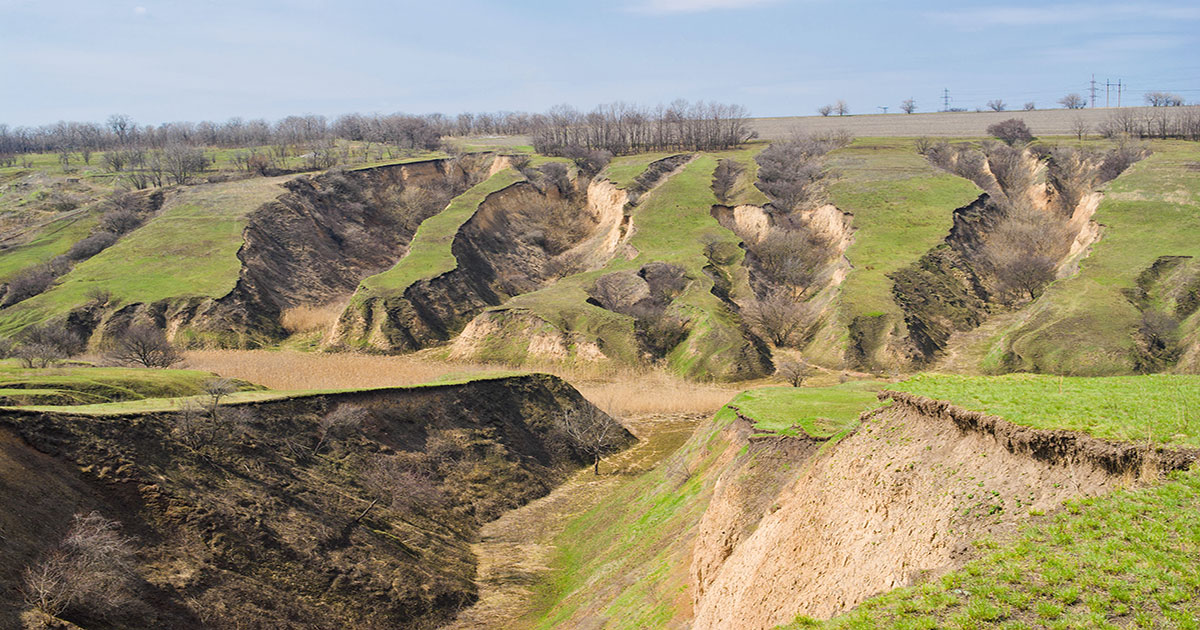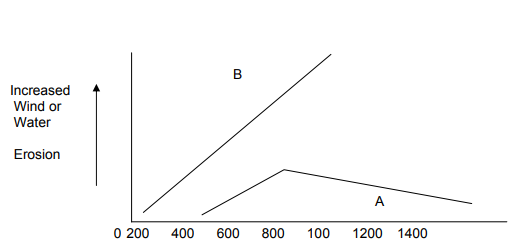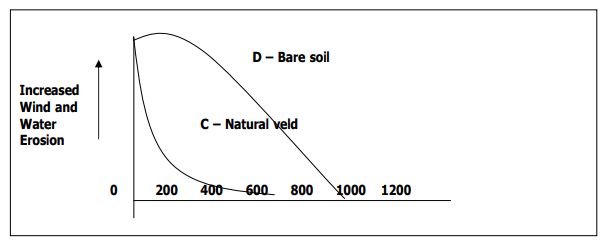Erosion is the removal of weather-beaten soil material from a site and deposited elsewhere to form or change the landscape.
Erosion takes place in two ways: the slow process or natural erosion and the accelerated erosion that occurs where the natural equilibrium had been disturbed. This type of erosion occurs when the protective cover of natural vegetation was removed or destroyed. The result of this type of erosion is loss of productive soil and reduction of soil productivity over the long run.

There is an important relation between water and wind erosion, vegetative cover and annual rainfall. Water erosion increases with the increasing of annual rainfall, on natural veld as well as on bare soil. The effect of water erosion is much higher on the bare soil than on a veld with natural vegetation.

Line A represents natural veld and shows the increase of water erosion from dry to wetter conditions.
Erosion decreases when rainfall and vegetation covering increase. Line B reflects water erosion on bare soil and clearly shows its increasing with the quantity of rainfall Wind erosion is a problem in the drier or more arid land areas. Natural vegetation management is very important as the natural veld covering reduces the effect of both wind and water erosion - see the following graph where D represents the effect of wind erosion on bare soil and C represents the effect of wind erosion on natural veld in the more arid land areas.

Causes of Soil Erosion
Increasing pressure on land resources: As the population grows, so do the needs grow for more food, housing and infrastructure? The demand for housing and infrastructure, unfortunately, takes up agricultural land, thus decreasing the production area while the need for food increases.
The result can be seen in both crop and animal production.
The natural veld and resources are pressurised by the increasing of animals which must provide for the daily needs. The increasing animal population is detrimental to veld management - overgrazing can cause erosion as the natural veld covering is reduced.
In the case of crop production, the farmer is now forced to use areas normally not suitable for cultivation - water erosion increases on the bare soil.
Economic influences: Because of unrealistic prices for products and land – due to demand and supply - the farmer is propelled to produce more and more. The natural resources cannot support the extra production burden – yield\ha is limited – he is therefore forced to use low producing soil where sustainable systems – erosion – can not be applied. Factors such as profit margins and increasing input and labour costs also add to this compulsory extension plan.
Incorrect Farming systems: Farming systems, not taking the natural resources into account, will result in overgrazing and bare areas where the soil is exposed to water erosion. The overexploitation of cropland and grazing in certain areas of the land is very detrimental. New farmers or communities are placed on productive farms not knowing the soil- or veld type, thus resulting in the neglect of sustaining natural resources.
Lack of Knowledge and Expertise: New farmers or communities that get land through various government schemes or land restitution do not have the knowledge to use the natural resources correctly. These new farmers need to be trained and assisted by the department of agriculture to be successful before the land is handed over to them. Communal farming systems used in the rural areas is also detrimental to the natural resources as there is no infrastructure to enclose animals resulting in over utilisation of the natural resources.
Inadequate law Enforcement: The laws regarding the preservation and care of natural resources are not enforced due to the lack of manpower or the lack of knowledge. The Department of Agriculture must fulfil its function regarding the maintenance and management of natural resources.
Farm Planning: Poor fences, lack of watering points, roads and preventative structures to stop erosion contribute to the problem of erosion. Poor construction of contours and waterways can cause major problems regarding water erosion in croplands.